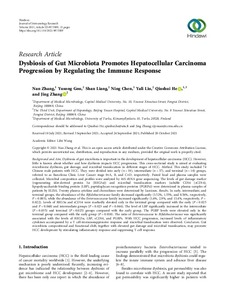| dc.contributor.author | Liang Shan | |
| dc.contributor.author | Liu Yali | |
| dc.contributor.author | He Qiushui | |
| dc.contributor.author | Zhang Nan | |
| dc.contributor.author | Chen Ning | |
| dc.contributor.author | Gou Yusong | |
| dc.contributor.author | Zhang Jing | |
| dc.date.accessioned | 2022-10-28T12:29:04Z | |
| dc.date.available | 2022-10-28T12:29:04Z | |
| dc.identifier.uri | https://www.utupub.fi/handle/10024/159830 | |
| dc.description.abstract | <p><em>Background and Aim.</em> Dysbiosis of gut microbiota is important in the development of hepatocellular carcinoma (HCC). However, little is known about whether and how dysbiosis impacts HCC progression. This cross-sectional study is aimed at evaluating microbiome dysbiosis, gut damage, and microbial translocation in different stages of HCC. <em>Method.</em> This study included 74 Chinese male patients with HCC. They were divided into early (<em>n</em>=19), intermediate (<em>n</em>=37), and terminal (<em>n</em>=18) groups, referred to as Barcelona Clinic Liver Cancer stage 0+A, B, and C+D, respectively. Paired fecal and plasma samples were collected. Microbial composition and profiles were analyzed by 16S rRNA gene sequencing. The levels of gut damage marker (regenerating islet-derived protein 3 alpha (REG3 alpha)) and microbial translocation markers (soluble CD14 (sCD14), lipopolysaccharide-binding protein (LBP), peptidoglycan recognition proteins (PGRPs)) were determined in plasma samples of patients by ELISA. Twenty plasma cytokine and chemokines were determined by Luminex. <em>Results.</em> In early, intermediate, and terminal groups, the abundance of the Bifidobacteriaceae family decreased significantly (3.52%, 1.55%, and 0.56%, respectively, P=0.003), while the abundance of the <em>Enterococcaceae</em> family increased significantly (1.6%, 2.9%, and 13.4%, respectively, <em>P</em>=0.022). Levels of REG3 alpha and sCD14 were markedly elevated only in the terminal group compared with the early (<em>P</em>=0.025 and <em>P</em>=0.048) and intermediate groups (<em>P</em>=0.023 and <em>P</em>=0.046). The level of LBP significantly increased in the intermediate (<em>P</em>=0.035) and terminal (<em>P</em>=0.025) groups compared with the early group. The PGRP levels were elevated only in the terminal group compared with the early group (<em>P</em>=0.018). The ratio of <em>Enterococcaceae</em> to <em>Bifidobacteriaceae</em> was significantly associated with the levels of REG3 alpha, LBP, sCD14, and PGRPs. With HCC progression, increased levels of inflammatory cytokines accompanied by a T cell-immunosuppressive response and microbial translocation were observed. Conclusion. Gut microbiota compositional and functional shift, together with elevated gut damage and microbial translocation, may promote HCC development by stimulating inflammatory response and suppressing T cell response.</p><p><br></p> | |
| dc.language.iso | en | |
| dc.publisher | HINDAWI LTD | |
| dc.title | Dysbiosis of Gut Microbiota Promotes Hepatocellular Carcinoma Progression by Regulating the Immune Response | |
| dc.identifier.url | https://www.hindawi.com/journals/jir/2021/4973589/ | |
| dc.identifier.urn | URN:NBN:fi-fe2022012710690 | |
| dc.relation.volume | 2021 | |
| dc.contributor.organization | fi=biolääketieteen laitos, yhteiset|en=Institute of Biomedicine| | |
| dc.contributor.organization-code | 2607100 | |
| dc.converis.publication-id | 68068247 | |
| dc.converis.url | https://research.utu.fi/converis/portal/Publication/68068247 | |
| dc.identifier.eissn | 2314-7156 | |
| dc.identifier.jour-issn | 2314-8861 | |
| dc.okm.affiliatedauthor | He, Qiushui | |
| dc.okm.discipline | 3111 Biolääketieteet | fi_FI |
| dc.okm.discipline | 3111 Biomedicine | en_GB |
| dc.okm.internationalcopublication | international co-publication | |
| dc.okm.internationality | International publication | |
| dc.okm.type | Journal article | |
| dc.publisher.country | Egypt | en_GB |
| dc.publisher.country | Egypti | fi_FI |
| dc.publisher.country-code | EG | |
| dc.relation.articlenumber | ARTN 4973589 | |
| dc.relation.doi | 10.1155/2021/4973589 | |
| dc.relation.ispartofjournal | Journal of Immunology Research | |
| dc.year.issued | 2021 | |
